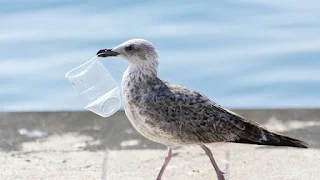-
Plastic waste in the ocean represents a growing problem for living organisms, including seabirds who often mistake it for food.
Plastic waste in the ocean represents a growing problem for living organisms, including seabirds who often mistake it for food.
A new study shows that plastics left to float in seawater likely release toxic chemicals into the water, and could do the same to birds' stomachs.
When the original plastic was left in water for six months, it seemed to cause a kind of froth to form on the surface, turning the mixture into “plastic soup.”
Dr Joby Razel Hollis, from the Natural History Museum, whose work focuses on the impact of plastic pollution on seabirds, said it was "shocking" to see the impact of microplastics on water in this study.
He explained in an interview with the Press Association (PA) news agency: “We are really interested in seeing how the plastic changes and also what it releases into the water... We have not only seen that some of this plastic has clearly changed color over time, but it has turned yellow as a result.” It was exposed to sunlight. And also because of the plastic that was floating in the water, after six months the water became a bit cloudy, and you can see that there is a kind of froth on the surface so these plastics are releasing something into the water as they decompose, and it's kind of like "What would you expect to see happening in the ocean?"
Experts say that it is known that about 44% of seabird species eat plastic, and some species are particularly severely affected, causing malnutrition and new diseases.
"The plastic in her stomach is certainly too large to pass and will not break down easily," Dr. Hollis explains. "But the problem is that from a chemical perspective, the stomach acid may be enough to release chemicals into the plastic, small amounts of it. But even a small amount can "It's very toxic, so we really want to know how this process happens."
Dr Hollis hopes that by measuring the different types of plastic they eat, as well as size, shape and colour, he will be able to understand why seabirds think plastic pollution is food, and what plastic causes the most harm when they eat it.
Scientists found that light-footed shearlings eat almost exclusively low-density plastics such as polyethylene, and this is likely because these species only feed near the ocean surface where these plastics float.






Informative
ReplyDeleteThese pose a danger to the oceanic animals.
ReplyDelete